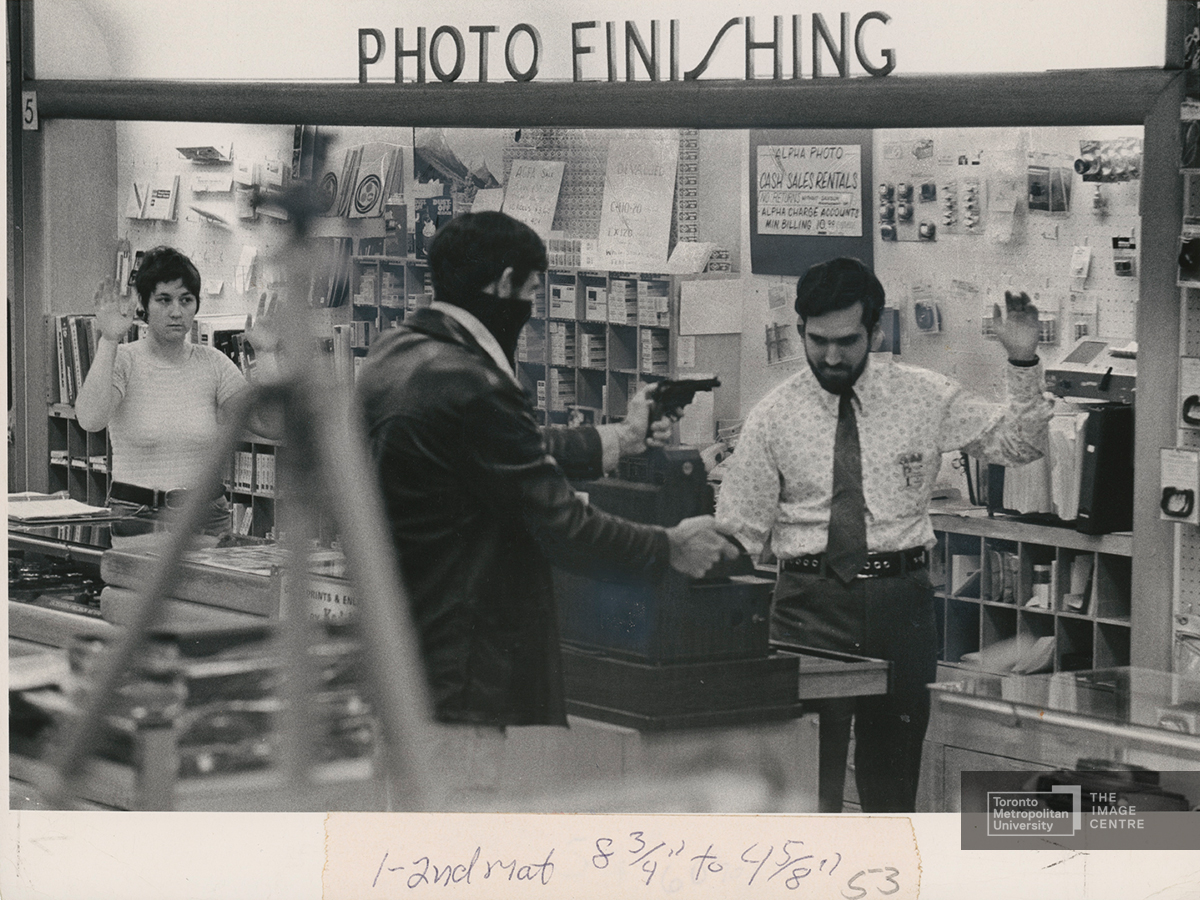Photoshop Hold-Up
Routine Activities Theory
Routine Activities Theory: crime occurs where a motivated offender (e.g. someone needing money), a suitable target (e.g. expensive cameras on display) and lack of guardianship (e.g. no police or security guards) all converge in the same time and place.
Title: Unknown.
Object Type: photograph
Dimensions: 8 x 10 inches; 20.32 x 25.4 cm
Medium: gelatin silver print
Date: 1973-03
Location: unknown
Accession No: BS.2005.267541
Photographer: Bob Fitch, American, b. 1939 d. 2016
Category: The Black Star Collection, Toronto Metropolitan University. Courtesy of The Image Centre.
Inscriptions: Recto, handwritten: # / 1-2nd mat 8 3//4" to 4 5//8" 53. Verso, handwritten: 4 [circled]; stamped: BOB FITCH / BLACK STAR; Typewritten: Oakland, Ca. photo shop hold up. 3//73 / (3675-); handwritten: 2 / 2 1//4; stamped: Negs Not In File; handwritten: POLICE / CRIMES

Museum Label by Jennifer Sansalone and Jessica Saldanha, CR8002 : Critical Engagement and Criminological Theories, Winter 2020
Born in Los Angeles, California on 20 July 1939, Bob Fitch was inspired to become involved with photography after reading “The Fire Next Time” by James Baldwin. Fitch wanted to portray certain aspects of the book such as Catholicism and the Civil Rights Movement. As a self-taught photographer, he was recruited by the Glide Foundation during the 1954-1968 Civil Rights Movement. After this, Fitch moved to Oakland where he photographed members of the United Farm Workers (UFW) union, especially its leader Cesar Chavez. They were protesting from 1968-1975 with demands for improved working conditions and living wages. Fitch continued his life’s work as an active participant and photographer for a variety of social justice movements until his death in 2016 from Parkinson's disease.
Civil rights and social justice movements were uniquely documented through photography. Instead of only recording these events in print-form, documentary photography rose in popularity by professional and self-employed photographers and photojournalists. Unlike most of Fitch’s other photographs, which focus on civil rights, this photo is of an armed robbery. From the 1960s to the 1970s, Oakland had a large increase in violent crime, especially robbery. Fitch likely frequented various photoshops throughout the city to purchase new equipment and develop film. One of those visits may have been to this store.
Robbers want to make the most money while reducing their risk of getting caught. They must remain calm while committing crimes so they do not make any mistakes because it takes a variety of planned efforts for a successful crime. The robber hides his identity with a bandana and a dark, over-sized leather jacket and wears items of clothing with large pockets. This allows him to conceal large amounts of stolen cash. The store sells a variety of expensive camera equipment, such as film and tripods, which are portable, lightweight and easy to move. Some of these items are clearly displayed on shelves or in glass display cases. It also advertises cash sales and print and enlargement services. It was taken during the store’s closing hours at night with only the manager and one other individual inside. During this time, there were limited security systems in place for the store’s protection. The only security available is law enforcement personnel but there are not many police officers on duty during the evenings and night shifts.
Bibliography
- Cullen, F. T., Agnew, R. and Wilcox, P. (2018) Part XI: Environmental Criminology. Criminological Theory: Past to Present, 6th Edition. pp. 390-403. New York: Oxford University Press.
- Gurudarshan, K. (2017). Bob Fitch photography archive (M1994). Dept. of Special Collections and University Archives. Retrieved from the Online Archive of California (external link, opens in new window)
- New York Times. (1971, September 10). Crime Rate Up 11% For Nation in 1970. Retrieved on April 6, 2020 from The New York Times (external link, opens in new window)
- Norris, C., (2012) "The success of failure", in Routledge Handbook of Surveillance Studies ed. Ball, K., Haggerty, K. D. & Lyon, D. Abingdon: Routledge, accessed 08 April 2020, Routledge Handbooks Online.
- Stanford University. (n.d.). The Bob Fitch Photography Archive. Retrieved from the Stanford Libraries (external link, opens in new window)
- The Art Story Foundation. (n.d.). Documentary Photography - Concepts & Styles. Retrieved April 8, 2020, from The Art Story Foundation (external link, opens in new window)
- The Changing Face of Oakland. (n.d.). Retrieved on April 7, 2020 from Oakland Planning History (external link, opens in new window)